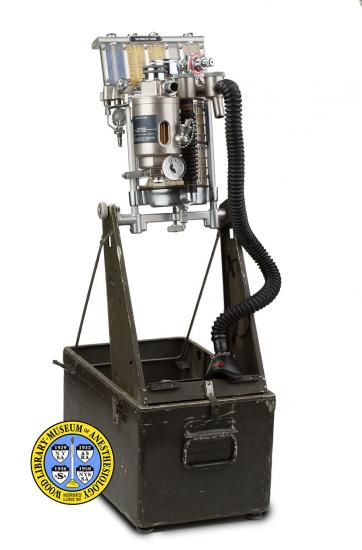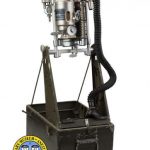Ohio 885
The Ohio Model 885 Field Anesthesia Machine was first tested during the Vietnam War (1956-1975), and continued to be developed over the succeeding years. It replaced the Ohio Model 785. Like its predecessors, it could administer nitrous oxide and oxygen. The cyclopropane flowmeter of the 775 was replaced on the 885 with an additional oxygen flowmeter. Both of the older vaporizers were removed, and replaced by a “universal” vaporizer. This could be calibrated to administer any one of the modern, non-explosive, liquid anesthetics: halothane, enflurane, or isoflurane. By the time of the Persian Gulf War (1990-1991), this unit had already been replaced by the Model 885A.
Catalog Record: Ohio 885
Access Key: akxl
Accession No.: 1993-03-10-1 C
Title: Model 885 / Ohio.
Corporate Author: Ohio Medical Products.
Title variation: Alt Title
Title: Ohio 885 field anesthesia machine.
Title variation: Alt Title
Title: Model 885 conversion.
Publisher: [Madison, Wisconsin] : Ohio, [between 1978 and 1987].
Physical Descript: 1 anesthesia machine : metals, plastics, glass, rubber, paint ; 105 x 26.5 x 54.5 cm.
Subject: Anesthesia Machines.
Subject: Medicine, Military.
Note Type: General
Notes: The date range for the possible year of manufacture was taken from table II:
military field anesthesia machines, page 71, of CDR Clayton Petty’s 1990
article, “Historical Perspective on the Evolution of Today’s Military Field
Anesthesia Machine.” Because it has not been determined with certainty wether
this machine was a 885 conversion or a new model (885A) the dates for both
885 conversions and new models without oxygen analyzers was included. If the
manufacturer marking “Model 885” (without an A) indicates that this was a
conversion, the the date range would be 1978-1985. The date range could
change if documentation indicates the range should be corrected.
Note Type: Citation
Notes: Kingsley CP, Hersack RA, Ellis JS Jr, Perkins D, McQuillan PM. Anesthesia in
the military arena. In: Russell GB, ed. Alternate-Site Anesthesia: Clinical
Practice Outside the Operating Room. Boston: Butterworth-Heinemann;
1997:410-412.
Note Type: Citation
Notes: Model 885 Conversion: … Instruction and Service Manual with Illustrated
Parts List. Madison, Wisconsin: Ohio Medical Products; [1981?].
Note Type: Citation
Notes: Petty C. Historical perspective on the evolution of today’s military field
anesthesia machine. Military Med. 1990;155(2):66-71.
Note Type: Citation
Notes: Petty WC. Military anesthesia machines. In: Zajtchuk R, Grande CM, eds.
Anesthesia and Perioperative Care of the Compat Casualty. Falls Church,
Virginia: Office of The Surgeon General United States Army; 1995:141-174.
https://ke.army.mil/bordeninstitute/published_volumes/anesthesia/ANch7.pdf.
September 22, 2014. [Largely covers the Ohio Model 885, and a little about
the Ohmeda Universal Portable Anesthesia Circuit.]
Note Type: Physical Description
Notes: One military field anesthesia machine that packs into a carrying case for
transport; The case is aluminum and painted dark green; This description
treats the side where the connections for the breathing circuit are located
as the front of the machine; Including the lower case, the measurements when
assembled are approximately 105 x 37 x 54.5 cm; With the case packed and
closed the measurements are approximately 48 x 37 x 54.5 cm; The control head
pivots into an upright operational position; The control head includes a
panel of flowmeters; A bar at the top of the flowmeter bank has a metal plate
marked, “”Ohio”, “MODEL 885”, new line, “SERIAL NUMBER”, new line,
“TGEF00151”; A white “Metabolic” O2 flowmeter is on the far right and marked
in liters per minute; Its control knob is fluted and has a white label marked
“O2”; Two yellow vaporizer oxygen flowmeters are in the center; They are
yellow and marked in cc per minute; The vaporizer oxygen flowmeter on the
left is for low flow (from 20 to 180 cc/min.) and the one on the right is for
high flow (from 100 to 1000 cc/min.); The blue flowmeter on the far left is
for N2O and is marked in liters per minute; Below the flowmeter bank is an
absorber composed of two plastic canisters protected by a grid of metal wire;
An “OXYGEN FLUSH” push button is located directly below the oxygen high flow
flowmeter; An adjustable pressure relief valve is located to the right of a
breathing circuit pressure gauge; This pressure gauge is marked in increments
of mercury on the outer scale and centimeters of water in the inner scale;
“Ohio” is also marked on the gauge; In front of the pressure relief valve and
pressure gauge are an inhalation check valve and an exhalation check valve,
which are covered with transparent windows to permit observation of the
valves; To the left of the pressure gauge is a non-adjustable pressure relief
valve; On the left front side of the head is the vaporizer; On top it has an
“ON” and an “OFF” control button; On the side is a filling funnel, a liquid
level indicator, and a temperature gauge (in Celsius); A drain spigot is
located on the bottom; A number of items are stored in the bottom part of the
case, including a small hinged storage shelf, a round flow calculator for the
vaporizer, a tray with holes to stabilize gas cylinders, and wrenches; The
upper part of the case is designed to store a number of items such as gas
supply hoses, a head strap, breathing tubes and bags, regulator assemblies
and a clipboard; The “INSTRUCTIONS FOR SETTING UP ANESTHESIA APPARATUS FOR
NORMAL USE”, and instructions for, “REPACKING FOR STORAGE OR SHIPMENT”, are
printed onto the clipboard stored in the upper lid.
Note Type: Reproduction
Notes: Photographed by Mr. Steve Donisch, September 20, 2013.
Note Type: Acquisition
Notes: Donated to the WLM by the manufacturer Ohmeda; Donation facilitated by Dr.
Rod Calverley, Ms. Lisa Papp, and Mr. Jeff Schultz.
Note Type: Historical
Notes: The Model 885A was one of the anesthesia machines used by the U.S. during the
Gulf War. It was designed by Ohio Medical Products engineer Wayne Hay based
on input from Army anesthesiologists. Planning for the model began in 1972,
and in 1977 Ohio was contracted to convert all Model 785s to 885s. Once the
conversions were completed, Ohio built new machines based on the 885 design.
These were referred to as Model 885A machines.
While the 885 was compact and rugged like its predecessors, models 685 and
785, a number of features were significantly different. The cyclopropane
flowmeter on the 785 was replaced with a second oxygen (O2) flowmeter. This
flowmeter directed O2 only to the vaporizer. To enhance the versatility of
the machine, the 885 was equipped with a universal vaporizer, one that would
allow the anesthesiologist to use whatever agent was available where ever the
machine was deployed. A round flow calculator accompanied the vaporizer to
help the anesthesiologist determine the vaporizer flowmeter setting that
would produce a desired concentration of anesthetic vapor. By 1981 the
calculator included scales for halothane, isoflurane, ether, enflurane and
methoxyflurane.
Other changes included a fluted oxygen knob, a pediatric breathing circuit,
and a safety valve that would stop the flow of nitrous oxide if the oxygen
line pressure became less than 20 psi. In 1988, an oxygen analyzer was added
to the breathing circuit.
Note Type: Publication
Notes: Bendele JG, Chester WL. Hidden obstruction of field anesthesia machine. U.S.
Navy Med. January-February, 1987;78(1):16-19.
Note Type: Publication
Notes: Hardaway RM. Care of the Wounded in Vietnam. Manhattan, Kansas: Sunflower
University Press; 1988.
Note Type: Exhibition
Notes: Selected for the WLM website.


